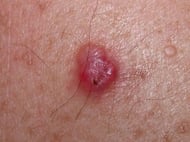Melanoma: An overview
Melanoma is a form of skin cancer arising from abnormal, uncontrolled growth of cells known as melanocytes. Melanoma is particularly dangerous because - if not detected and treated early - it can spread to other organs of the body and become fatal.
Understanding the causes, risk factors and warning signs for melanoma can help you spot these skin cancers early when they are easiest to treat.
What causes melanoma?
Melanoma originates in melanocyte cells. Melanocytes are skin cells in the upper layer of skin which produce a pigment called melanin, which gives skin its colour. When skin is exposed to ultraviolet (UV) radiation - such as from the sun or solariums - it causes DNA damage that triggers mutations in the melanocytes, resulting in uncontrolled cellular growth.
Melanoma can also be caused by environmental or genetic factors. For example, people with a first-degree relative (parent, sibling or child) with melanoma have a 50 per cent increased risk of developing the disease themselves.
Only 20-30 per cent of melanomas arise from existing moles, while 70-80 per cent are newly formed.
What does melanoma look like?
Melanoma takes many different shapes, colours and sizes. It looks different on everyone, which is why it can be so difficult to self-detect and why regular skin cancer checks with a professional are so important.
Read more about the ABCDEFG method of checking for melanoma.
There are multiple types of melanoma, including nodular melanoma, lentigo maligna, acral lentiginous melanoma, and superficial spreading melanoma.
The most important things to look out for are new moles; any changes to the shape, size or colour of existing moles; and anything that stands out as different to the other lesions on your body.
Remember, melanoma can develop anywhere on the body, including the soles of your feet, under your nail beds, in your mouth, on your genitals, and even on your eyes.
The below images are examples of real melanomas.


-1-1-3.png?width=190&name=Nodular%20melanoma%20(1)-1-1-3.png)
-1.jpeg?width=190&name=Wide%20Shot%20Lesion%20Marked%20(1)-1.jpeg)
Is melanoma dangerous?
Melanoma becomes more dangerous the longer it is left untreated, as it can spread into other organs of the body. About 2,000 people die from melanoma each year in Australia.
There are different stages of melanoma, ranging from stage 0 (the most superficial, early melanomas) to stage 4 (the most advanced, spreading melanomas).
Melanoma is the most common cancer affecting young Australians aged 15-39.
Who is at risk of melanoma?
Any of the below factors can put you at higher risk of developing melanoma:
- A family or personal history of melanoma
- UV exposure from the sun or tanning beds
- Age over 50
- Fair skin or light-coloured hair or eyes
- Male
- Having multiple moles on your body
- A compromised immune system
- Five or more sunburns
- Working outdoors
- Spending a lot of time in the sun
To find out your skin cancer risk, take our quick quiz.
Having just 5 sunburns doubles your melanoma risk.
How can melanoma be prevented?
Skin cancer is a largely preventable disease. You can protect yourself against developing melanoma by adopting sun safe habits like wearing sunscreen, a hat, sunglasses, and long sleeves; seeking shade whenever you are outdoors; and avoiding going outside in UV peak times (usually between 10.00am – 2.00pm).
It’s also important to keep an eye on your own skin for anything new, changing or unusual, and get a professional skin cancer check at least once a year (or more often if you are at high risk of skin cancer).
If you or your immediate family have had melanoma before, be extra vigilant and be sure to get more frequent check-ups.
The key to melanoma survival is early detection, which increases chances of survival by up to 99 per cent.
Learn more about preventing skin cancer here.
How is melanoma treated?
Treatment options for melanoma can include:
- Surgical removal, where the cancer is cut out;
- Immunotherapy, in which your immune system is stimulated to kill the cancer cells;
- Chemotherapy, where tumour growth is stopped using certain medicines that either kill cancer cells or stop them from multiplying; and/or
- Radiation therapy, in which the cancer is destroyed with beams of intense energy.
More advanced or metastatic (spreading) melanomas may require more extensive treatment.
Learn more about skin cancer treatments here.
